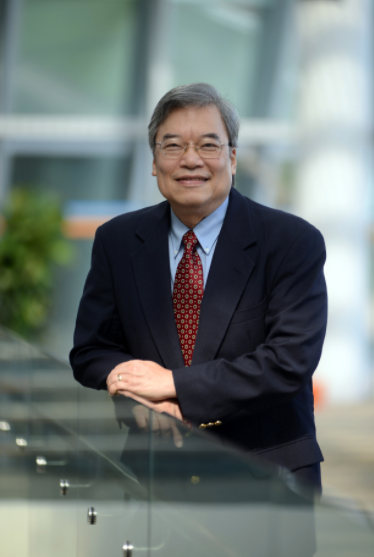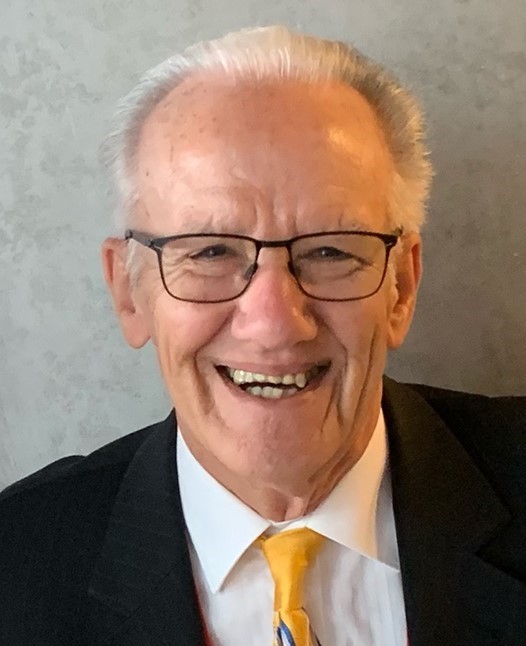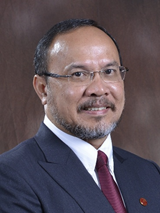Speaker 2020
Keynote Speaker I

Prof. Philip L-F. Liu
Department of Civil and Environmental Engineering
National University of Singapore
Talk Title: Recent Advancement in Modelling Wave – Current – Bathymetry interactions
Abstract:
A depth-integrated wave--current model has been developed to investigate waves on currents with arbitrarily vertical shear. The model is derived from Euler’s equations in the σ-coordinate, which maps the total water depth in the Cartesian coordinates onto a specified range of σ-coordinate. The model is the extension of Yang & Liu (J. Fluid Mech. 2020), in which both the waves and currents are approximated as truncated infinite series of products of prescribed shape functions of σ and unknown functions of horizontal coordinates and time. Therefore, the current profiles are restricted by the degree of polynomial employed. In the new model, the total horizontal velocity is decomposed into two components: one of them can be deduced to the prescribed steady-state current with arbitrarily vertical shear in the absence of waves, and another component is approximated in the polynomial form. The total horizontal velocity is required to satisfy the Euler's equations and boundary conditions. Consequently, the vertical structure of the current field can be arbitrary.
Adopting the method of weighted residuals, the new models are obtained by minimizing the residuals of the horizontal momentum equations with either the Galerkin method or the subdomain method. The numerical model has been validated by theoretical results of linear wave dispersion relation on arbitrarily sheared current, and laboratory experiments of wave propagation over sheared currents. Furthermore, monochromatic waves and solitary waves on non-uniformly sheared current are also investigated numerically. The resulting wave properties, vorticity, and velocity field under wave--current interactions are discussed accordingly. Several three-dimensional applications of wave—current—bathymetry interaction are also discussed.
Bio:
Philip L.-F. Liu is the Distinguished Professor in the Department of Civil and Environmental Engineering at NUS. Liu is also an Honorary Professor in Tsinghua University, China, the Li Kwoh-Ting Chair Professor in National Central University, Taiwan, and the Class of 1912 Professor in Engineering, Emeritus, in Cornell University, USA.
After graduating with a B.S. degree in Civil Engineering from National Taiwan University in 1968, Prof. Liu received a S.M. degree in Civil Engineering in 1971 and a ScD degree in 1974 from Massachusetts Institute of Technology. He joined Cornell faculty as an Assistant Professor in the School of CEE in 1974 and was promoted to Full Professor in 1983. Prof. Liu served as the Associate Director of the School in 1985-1986 and as the Associate Dean for Undergraduate Studies of Engineering College in 1986-1987. He was the Director of the School of CEE from July 1, 2009 to June 30, 2015. From August 2015 to July 2019, Prof. Liu served as the Vice President for Research and Technology at the National University of Singapore.
Prof. Liu is a member of the National Academy of Engineering (USA), an Academician of Academia Sinica (Taiwan), a Fellow of the American Geophysical Union, and a Distinguished Member of the American Society of Civil Engineers. He also received the ASCE Walter L. Huber Civil Engineering Research Prize (1978), the J. S. Guggenheim Fellowship (1980), the ASCE John G. Maffatt & Frank N. Nichol Harbor and Coastal Engineering Award (1997), the International Coastal Engineering Award ASCE (2004), the Alexander von Humboldt Research Award (2009), and the International Award for Enhancement of Tsunami/Coastal Disaster Resilience (2017).
Keynote Speaker II

Prof. George Baird
School of Architecture, Victoria University of Wellington, New Zealand
Talk Title: Sustainable Buildings – their performance in practice from the point of view of the occupants
Abstract: In his keynote address Prof Baird will summarise some of the main findings from a world-wide survey of the occupants of over 30 sustainability-credentialed commercial and institutional buildings located in a range of climatic zones. The first part of the presentation will detail the distributions of the perception scores for each one of the forty-five aspects on which responses were sought from the occupants during the surveys. These distributions support the view that users are well able to assess variations in a wide range of aspects of the premises they occupy and that more systematic use should be made of their perception scores in building design and evaluation. The second part will outline what features appeared to enhance the comfort, health and productivity of the occupants; and identify the ‘best’ and ‘worst’ buildings of those surveyed based on an index that takes account of 11 key variables. His presentation will conclude with a discussion and summary of the design features associated with these results.
Bio: George Baird is Emeritus Professor of Building Science at the School of Architecture, Victoria University of Wellington, specialising in building environmental science and the assessment of building performance from the point of view of the users.
He is a Fellow of the Chartered Institution of Building Services Engineers (UK) and of Engineering New Zealand, and was awarded Life Membership of the Energy Management Association (now Carbon and Energy Professionals) of New Zealand in 2013.
He received the NZ Science and Technology Bronze Medal in 1999, the international “Pioneers of the World Renewable Energy Network” Award in 2006 and was appointed a Fellow of the Architectural Science Association at their 50th Annual Conference in 2016.
Dr Baird has authored innumerable conference papers and journal articles over the last half century. Major books include: Energy Performance of Buildings; Building Evaluation Techniques; Architectural Expression of Environmental Control Systems; and most recently Sustainable Buildings in Practice, a worldwide survey of sustainable buildings.
Still active in his field, he was an invited speaker at the recent World Sustainable Building Conference in Hong Kong and the Passive and Low Energy Architecture Conference in Edinburgh, and is a member of the editorial boards of several journals in the field of architectural science, including Architectural Science Review, Journal of Building Engineering, Intelligent Buildings International, and Buildings.
For further details see: http://www.victoria.ac.nz/architecture/staff/george-baird.aspx
Keynote Speaker III

Prof. Ir. Dr. Ramli Nazir
Tropical Geoengineering Centre, Universiti Teknologi Malaysia, Skudai, Johor, Malaysia
Speech Title: Migration Pattern of Liquid in Porous Soil Due to Earthquake Effect
Abstract: A rapid growth and development of country has contributed to the underground storage tank leakage and surface spillage of hydrocarbon liquid and industrial chemicals into the porosity subsurface. This led to groundwater contamination of liquid namely aqueous phase liquids (APL) and non-aqueous phase liquids (NAPL) which cause a harmful effect on the environment and health issues. A comprehensive understanding of contaminate migration is important to ensure the sustainability of geo-environmental and groundwater utilization. This keynote address is intended to make understand the phenomena and characteristic of APL and NAPL migrations in porous soil under earthquake effect and intact condition. A laboratory fluid migration model was simulated to show the effect of earthquake using double-porosity soil and its response using vibration table and accelerometer. The APL and NAPL migrate simulation results were obtained using digital image processing techniques. The recorded images were analyzed using Matlab special self-development routine and Surfer software to plot the hue saturation intensity (HSI) of the APL and NAPL migration characteristic. Similar method was deployed to develop a NAPL saturation calibration curve for verifying the hue values of the image to the actual NAPL saturation in fractured double-porosity soil. The multiphase flow and pollutant transport model for NAPL migration developed by Galerkin’s weighted-residual method was employed with the temporal discretization via implicit scheme. The simulated results using saturation calibration curve data compared to the works of previous researchers for validation purposes. The outcome shows that the deformable double-porosity soil has more fractured pores compare to the intact double-porosity soil. From the acceleration response analysis, it was seen that the soil samples has amplification and dis-amplification shaking. Thus, the fractured double-porosity soil has high permeability due to faster APL and NAPL migration and not uniformly downward due to the non-homogeneity of the fractured double-porosity under vibration process compared to intact double-porosity soil. The multiphase immiscible flow and pollutant transport model produce a faster penetration of NAPL in fractured double-porosity soil compared to intact double-porosity and single-porosity soil. In conclusion, it has shown that study can benefit researchers to comprehensively understand and simulate the liquids migration pattern that influence the groundwater resources. It is useful for future environmental sustainability of natural resources especially in susceptible earthquake zone area.
Bio: Ir. DR. Hj. Ramli bin Hj. Nazir is a Professor in Geotechnical Engineering at Geotechnical and Transportation Department, Universiti Teknologi Malaysia since 1989. Holds a B. Civil Eng.in 1983 from UTM and PhD from the University of Liverpool in 1994 and specialized in Geotechnical Engineering. He has more than 30 years' experience in the field of Geotechnical Engineering, specifically in Foundations, Ground Improvement and Geotechnical Forensics Engineering. He has published more than 100 technical papers and Journals related to his field of expertise. In addition as a Lecturer in Geotechnical Engineering, he is also a Professional Engineer who have numerous experience as a Design Engineer, Design Checker and Geotechnical Technical Advisor to various government and private agencies which also involved in many Civil Forensic works including Structural and Infrastructures in Malaysia. In addition to engineering education and consultation activities, he is a Member of the Technical Committee on Eurocode 7 Malaysian Annex which responsible for regulating the use of Eurocode 7 according to local needs, Research Committee Members for Construction and Industrial Development Board of Malaysia, and Public Work Department Malaysia. He also provide an expertise support for Standards and Industrial Research Institute of Malaysia (SIRIM) and Public Work Department (JKR), in the design specification work for specialized work such as Soil Anchor and Load Testing. He is also a member of National Slope Failure Enquiry Commissioner. He is also an invited Geotechnical speaker for training and workshops to government and private technical agencies such as JKR, PETRONAS, SHELL, Malaysia Productivity Corporation and many more. Currently Prof. Ramli is a Senior Deputy Director for Tropical Geoengineering, Universiti Teknologi Malaysia.